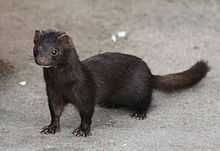Mink
| Mink | |
|---|---|
 | |
| European Mink | |
 | |
| American Mink | |
| Scientific classification | |
| Kingdom: | Animalia |
| Phylum: | Chordata |
| Class: | Mammalia |
| Order: | Carnivora |
| Superfamily: | Musteloidea |
| Family: | Mustelidae |
| Subfamily: | Mustelinae |
| Genus: | Neovison and Mustela |
| Species | |
|
Neovison vison | |
Mink is a common name for an alert, semiaquatic, carnivorous mammal of the Mustelidae family which also includes otters, weasels, badgers, wolverines, and polecats. There are two extant species in the subfamily Mustelinae, i.e. the American mink (Neovison vison) and the European mink (Mustela lutreola). There is also one extinct species, the Sea mink (Neovison macrodon) which is related to the American mink, but is much larger. All three species are dark-coloured.

The American mink is larger and more adaptable than the European mink. It is sometimes possible to distinguish between the two species; European mink always have a large white patch on the upper lip, whereas the American species sometimes does not. Therefore, any mink without a patch can be identified as an American mink, but individuals with a patch cannot be positively identified without examination of the skeleton. Taxonomically, both American and European mink were historically placed in the same genus, Mustela (weasels), but more recently, the American mink has been re-classified to its own genus, Neovison.[1]
The fur of the American mink has been highly prized for its use in clothing, with hunting being replaced by farming. Its treatment has also been a focus of animal rights and animal welfare[2] activism. American mink have become established in the wild in Europe and South America after escaping or being released from captivity.
American mink are believed to have contributed to the decline of the less hardy European mink through competition (though not through hybridization; native European mink are closer to polecats than to the North American species).[3] Trapping is used to control or eradicate feral American mink populations,[4] as is hunting with packs of hounds in the British Isles.
Mink are primarily nocturnal, but border on being crepuscular.[5][6]
Mink oil is used in some medical products and cosmetics, as well as to treat, preserve, and waterproof leather.
Diet
Both the American and European mink are semiaquatic carnivores. Their diet mostly consists of fish, birds, small rodents, amphibians, crustaceans, and insects depending on its ecological niche. Voles are one of the primary targets for both mink species and as a result of this, some vole species are experiencing a significant population decline.
See also
References
- ↑ Integrated Taxonomic Information System: mink. Accessed 10 August 2009
- ↑ Dutch minister reverses battery and mink ban
- ↑ Lodé T., Guiral G. & Peltier D. (2005). European mink-polecat hybridisation events: hazards from natural process? Journal of Heredity 96 (2): 1-8
- ↑ Haworth, Jenny (3 February 2009) "National cull may exterminate UK mink". Edinburgh. The Scotsman.
- ↑ Bear Tracker
- ↑ Wildlife Conservation Research Unit
External links
| Wikimedia Commons has media related to Neovison. |
| Wikispecies has information related to: Neovison |
- Nature Works definition of the American Minks - Neovison Vison
- New York State Department of Environmental Conservation profile of Minks
- Animalspot.net information page on Minks